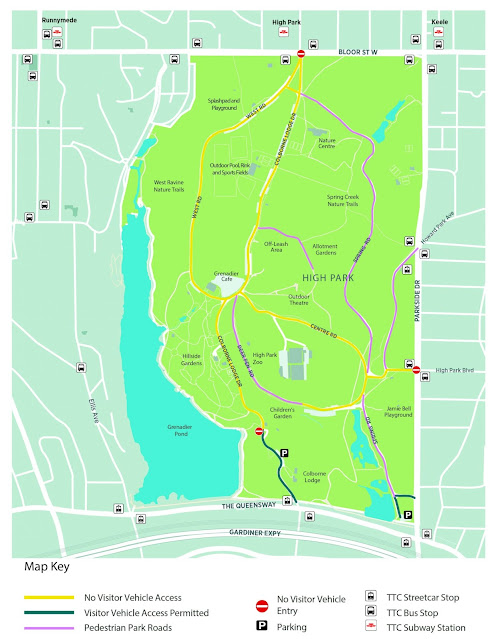High Park Movement Strategy
The High Park Movement Strategy was first brought up last November when Councillor Gord Perks brought forward a motion in response to the deaths of Valdemar and Fatima Avila at Parkside and Spring the month prior. Perks claimed at the time it was the quickest way to secure safety improvements on Parkside Drive. Another motion was debated at the Infrastructure & Environment Committee in May 2022 which looked at various street design options, while a separate Parkside Drive Study has been launched in conjunction with the Movement Strategy. Those wishing to focus on Parkside should complete the survey by Sunday, August 28.
The Movement Strategy – which will have a virtual open house on Wednesday, July 27 at 6:00 PM – will focus on the future of the weekend road closures within High Park. These closures have been well received with 75% of survey respondents saying they had a positive impact when visiting the park (compared to 13% who disagreed). Despite this high approval, Diane Buckell started a petition eight months ago calling for High Park to be reopened to motor vehicles which got almost 1000 signatures at the time of writing. There are still some concerns such as increased street parking and neighbourhood traffic which do need to be addressed as part of the Movement Strategy.
Four options are being proposed which are the following:
- No visitor vehicles allowed (pure carfree)
- No visitor vehicles allowed at scheduled times (similar to current situation)
- No visitor vehicles allowed on certain roads (partially carfree)
- Visitor vehicles allowed (per-COVID status quo)
 |
| Option #1 (pure carfree) from the City of Toronto's High Park Movement Stratgy |
Pursuing the pure carfree option (#1) would allow for radical road reconfigurations to improve pedestrian and cycling access, while still allowing some transit and shuttle services. Such a move would also provide opportunities to re-naturalize some of the paved areas (e.g. parking lots). While this would be the preferred solution, I would like to suggest a counter-proposal to Option #3 in case the political will is not there to fully close off High Park to motor vehicles.
Instead of opening the High Park Loop to motor vehicles, the City should close it and consider opening Centre Road from Parkside Drive to Grenadier Café. This is something Gil Penalosa – who recently declared his candidacy for Mayor – suggested a while back.
 |
| Gil Penalosa's proposal for a High Park pilot which he shared on Twitter several times |
Kensington Safe Streets
While the idea of High Park going carfree gained some momentum thanks to the popularity of the weekend road closures, things are less optimistic for Kensington Market. Despite the popularity of Pedestrian Sundays and calls for a carfree Kensington Market dating back decades, supporters of pedestrianization will be disappointed when they review the consultation materials for the upcoming virtual meeting on Monday, July 18 at 6:30 PM. Despite pedestrianization being the standout top design principle per the respondents of the Phase 1 survey, only one block of Baldwin Avenue is being considered for this treatment which itself is one of three options for that street.
 |
| A carfree option for Baldwin Avenue in Kensington Market (via City of Toronto) |
The City’s website stated the current project scope does not include pedestrianization, but that the proposed solutions would be flexible enough to accommodate different uses and configurations and would not preclude the possibility of pedestrianization in the future. Given the planned watermain replacement and road reconstruction scheduled for 2023, the City’s proposal to limit pedestrianization to one block is nothing short of squandering a once in a generation opportunity to implement a bold new vision for Kensington Market. Given this epic failure on the City’s part, this project needs to be sent back to the drawing board to better reflect current priorities such as Vision Zero and TransformTO.
The proposed solutions include widening sidewalks, adding curb extensions and/or bumpouts, and implementing raised crosswalks and intersections. Some streets such as Augusta Avenue and Nassau Street will be narrowed to six metres to accommodate wider sidewalks. St. Andrew Street will see the most significant narrowing from 8.8 metres to 6.8 metres. For Baldwin Avenue, the two other options being proposed aside from pedestrianization (#3) are a raised mixed-use shared street (#2) and curbs, parking, and loading (#1). While these may be improvements over the current situation, they are nowhere close to the bold vision that is needed.
 |
| Wider sidewalks (and narrower roads) are one part of Kensington Safe Streets (via City of Toronto) |
If you can’t make it to Monday’s meeting, please complete the survey by Tuesday, August 2 urging the City to send their plans for Kensington Market back to the drawing board and instead, implement a bold vision. In the event the City is not willing to reconsider, be sure to express your support for pedestrianizing Baldwin Avenue per Option #3.

No comments:
Post a Comment